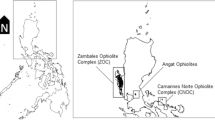Abstract
The effect of the outgassing of CO2 from a hydrothermal fluid on the C- and O-isotopic compositions of calcite, which is precipitated from this fluid, is quantitatively modelled in terms of batch and Rayleigh distillation equations. Both CO2 degassing and calcite precipitation are considered to be the removal mechanisms for dissolved carbon species from the fluid. Combined degassing-precipitation models are then developed by taking H2CO3 and HCO −3 , respectively, as the dominant dissolved carbon species. A positive correlation array between δ 13C and δ 13O values of calcite can be yielded by the precipitation of calcite from a H2CO −3 -dominant fluid, accompanied by a progressive decrease in temperature during CO2 degassing, whereas calcite precipitated from a HCO −3 -dominant fluid under the same conditions tends to display much smaller variation in δ 13C values than in δ 18O values. The combined processes of CO2 degassing and calcite precipitation result in lowering the δ 13C value of calcites with respect to those precipitated in a closed system simply due to temperature effect. Carbon and oxygen isotopic data for calcite from the Kushikino gold-mining area in Japan illustrate the application of quantitative modelling, and degassing of CO2 is suggested as a more likely cause for the precipitation of the calcite and quartz in this mining area.
Similar content being viewed by others
References
Bodnar, R. J., Reynolds, T. J., Kuehn, C. A.: Fluid inclusion systematics in epithermal systems. In: Berger, B. R., Bethke, P. M. (eds.) Geology and Geochemistry of Epithermal Systems, pp. 73–97. Reviews in Economic Geology, Vol. 2, Texas: Soc. Econ. Geol. (1985)
Clayton, R. N., O'Neil, J. R., Mayeda, T. K.: Oxygen isotope exchange between quartz and water. J. Geophys. Res. 77:3057–3067 (1972)
Gregory, R. T.: Oxygen isotopic systematics of quartz-magnetite pairs from Precambrian iron formations: Evidence for fluid-rock interaction during diagenesis and metamorphism. In: Walter, J. V., Wood, B. J. (eds.) Fluid-Rock Interaction during Metamorphism, pp. 132–153. Berlin Heidelberg New York: Springer 1986
Helgeson, H. C.: Thermodynamics of hydrothermal systems at elevated temperatures and pressure. Am. J. Sci. 267:729–804 (1969)
Holland, H. D., Malinin, S. D.: The solubility and occurrence of non-ore minerals. In: Barnes, H. L. (ed.) Geochemistry of Hydrothermal Ore Deposits, 2nd Edition, pp. 461–508. New York: John Wiley and Sons (1979)
Izawa, E., Yoshida, T., Sakai, T.: Fluid inclusion studies on the gold-silver quartz veins at Kushikino, Kagoshima, Japan. Soc. Mining Geologists Japan Spec. Issue 10:25–34 (1981)
Matsuhisa, Y., Morishita, Y., Sato, T.: Oxygen and carbon isotope variations in gold-bearing hydrothermal veins in the Kushikino mining area, southern Kyushu, Japan. Econ. Geol. 80:283–293 (1985)
McCrea, J. M.: On the isotopic chemistry of carbonates and a paleo-temperature scale. J. Chem. Phys. 18:849–857 (1950)
Nabelek, P. I., Labotka, T. C., O'Neil, J. R., Papike, J. J.: Contrasting fluid/rock interaction between the Notch Peak granitic intrusion and argillites and limestones in western Utah: evidence from stable isotope and phase assemblages. Contrib. Mineral. Petrol. 86:25–34 (1984)
Ohmoto, H.: Systematics of sulfur and carbon isotopes in hydrothermal ore deposits. Econ. Geol. 67:551–578 (1972)
Ohmoto, H., Rye, R. O.: Isotopes of sulfur and carbon. In: Barnes, H. L. (ed.) Geochemistry of Hydrothermal Ore Deposits, 2nd Edition, pp. 509–567. New York: John Wiley and Sons (1979)
O'Neil, J. R., Clayton, R. N., Mayeda, T. K.: Oxygen isotope fractionation in divalent metal carbonates. J. Chem. Phys. 51:5547–5558 (1969)
Rayleigh, L.: On the distillation of binary mixtures. Phil. Mag. Sci. 64:521–537 (1902)
Robinson, B. W.: Carbon and oxygen isotopic equilibria in hydrothermal calcites. Geochem. J. 9:43–46 (1975)
Truesdell, A. H.: Oxygen isotope activities and concentrations in aqueous salt solutions at elevated temperatures — Consequences for isotope geochemistry. Earth Planet. Sci. Lett. 23:387–396 (1974)
Valley, J. W.: Stable isotope geochemistry of metamorphic rocks. In: Valley, J. W., Taylor, H. P., Jr., O'Neil, J. R. O. (eds.) Stable Isotopes in High Temperature Geological Processes, pp. 445–489. Reviews in Mineralogy Vol. 16, Washington: Miner. Soc. America (1986)
Zheng, Y.-F.: The effect of Rayleigh degassing of magma on sulphur isotope composition: A quantitative evaluation. Terra Nova 2, 74–78 (1990)
Author information
Authors and Affiliations
Rights and permissions
About this article
Cite this article
Zheng, Y.F. Carbon-oxygen isotopic covariation in hydrothermal calcite during degassing of CO2 . Mineral. Deposita 25, 246–250 (1990). https://doi.org/10.1007/BF00198993
Received:
Accepted:
Issue Date:
DOI: https://doi.org/10.1007/BF00198993




